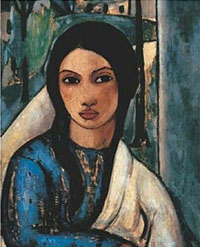In Cuba: Gitana Tropical in Her 80s
- Submitted by: admin
- Arts and Culture
- Caribbean
- culture an traditions
- Destinations
- national
- Paint and Sculpture
- personalities
- 03 / 22 / 2009

A particular, Cuban, vision that appropriated new events and patriotic symbols didn’t exist.
The new vision of Cuban identity appeared in national plastic arts from the hands of avant-garde artists in 1927, represented, among others, by Víctor Manuel, Carlos Enríquez, Eduardo Abela, Amelia Peláez and Marcelo Pogolotti.
Born in Havana in 1897, son of an employee of the San Alejandro Academy, Manuel García attended classes at the Academy from the age of 12. There he studied with Professor Leopoldo Romañach, and at 14 was appointed, off the record, professor of Elementary Drawing. García presented his first exhibition in 1924, and the following year traveled to Europe with the support of the Minorista Group (made up of young people with intellectual and political concerns led by Rubén Martínez Villena and Juan Marinello) and met avant-garde artists during his stay in Paris.
While in Montparnasse, a group of artists baptized him Víctor Manuel. For the Cuban, artists should be the offspring of their epoch and only paint when an authentic affective relation exists between the painter and the object of representation. This would allow them to capture the sentiments of the first 20 years of the Republic’s life in their plastic representations, an idea adopted by the painters mentioned above.
Back in Havana in 1927, he exhibited at the Painters and Sculptors Association, and the public crowded the exhibition rooms. It was the announcement of modernity. Painting is all that mattered to this herald of modern art in Cuba, re-discoverer of the national identity, kind, short in stature and very unassuming. He recreated his themes tirelessly: brown skinned women, with nostalgic gazes, and landscapes of the outskirts of Havana. As his friend poetess Concha Tormes Araque would say, “it was like the 20th century was established in Cuban painting with a single stroke”.
Once his style became much more defined, he began to teach free of charge with the intention of modifying the predominating academic classic style, while sponsoring the journal Revista Avance. Later, he traveled again to Europe and in 1929 paints his Gitana Tropical, that still today, eight decades after, arouses fascination. This portrait of a woman, painted in oil with vivid and luminous colors, is the first classic of Cuban pictorial modernism. It depicts an exotic mestiza with thick red lips, a blend of Cuban mulata with the hair and eyes of an indigenous woman. Victor Manuel was convinced that Cuban mulatas carried much of the gypsy.
Blue is the predominating color in the chromatic composition, placed with the conviction that it would transmit freshness. The long brush strokes intertwine and reveal small touches of white and gray. The rough black lines the artist uses to outline the contours are fauvist elements. The elaboration of the landscape is constantly surprising. Among the trees in the second plane, human figures can be seen. This painting is considered the Mona Lisa of the Caribbean. This seductive woman, image of Caribbean femininity and Latin sensuality, displays at the same time a nostalgic and kindly gaze, observes us and dialogues with us, as dazzling as the first day.
After his trip to Paris in 1929, the father of the golden era in Cuban painting, as he is also known, went to Belgium and Spain where he studied the grand masters, new techniques and primitive styles. His style evolved sharply during his life. In his last years, it became almost abstract and his portraits began to show a cubist proclivity. He was influenced by Gauguin, showing a discreet presence of Cezanne, Matisse and Modigliani. His main early works in Cuban modern art are: Paisaje, Paisaje gris, Vida Interior, Novios and Acuarela.
This emblematic artist, who died in February 1969, rediscovered and set painting in Cuba on the right path. Marcelo Pogolotti described him as the milestone marking a noticeable advance in Cuban painting.
(www.cubanow.net)
Comments